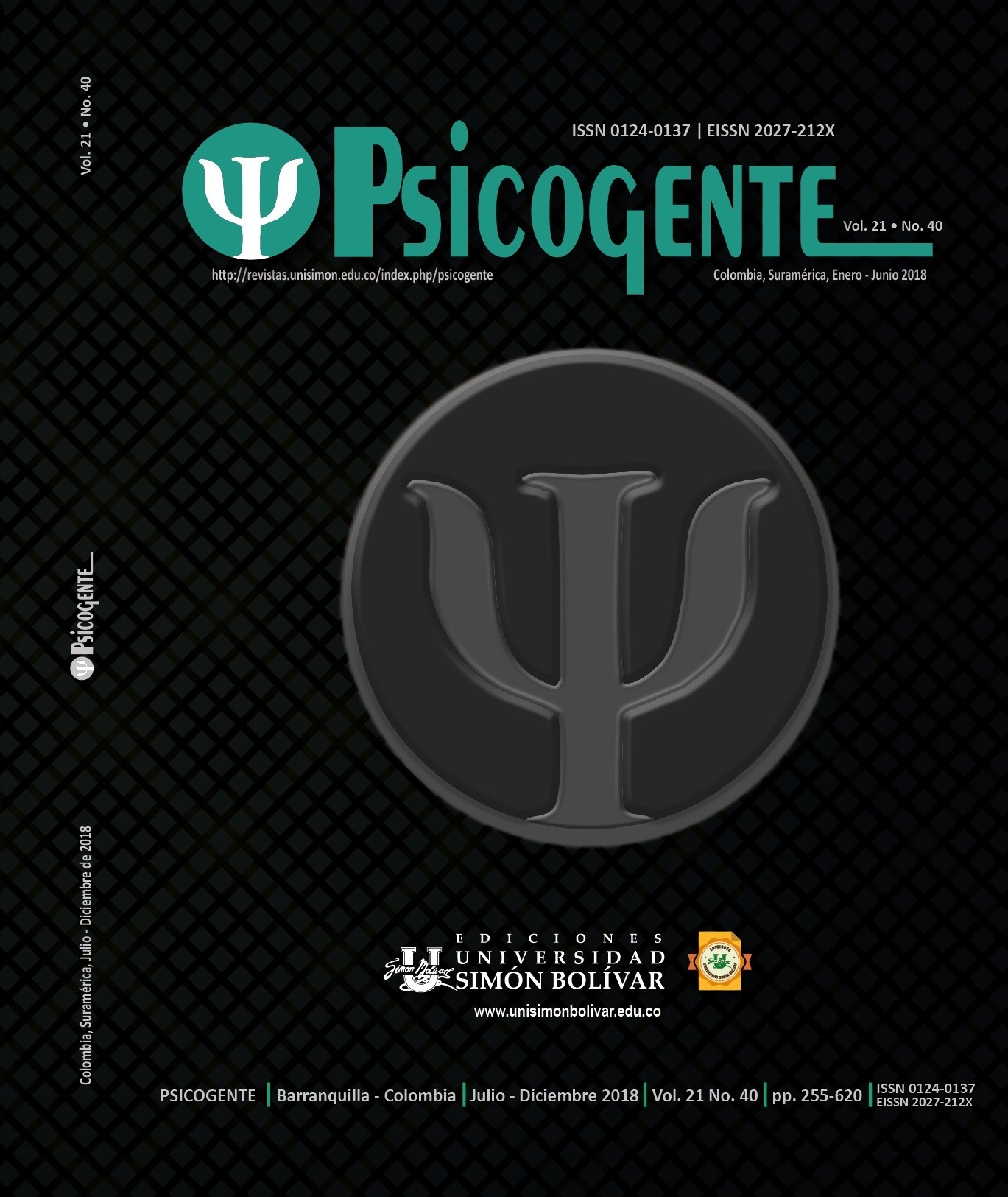Gramática espacial urbana: la orientación espacial guiada por reglas verbales
Spatial and urban grammar: spatial orientation focuses on verbal rules
DOI:
https://doi.org/10.17081/psico.22.41.3313Palabras clave:
cognición espacial, búsqueda de rutas, conducta guiada por reglas, orientación espacial.Resumen
Objetivo: Analizar el papel que juegan las reglas en forma de instrucciones verbales y conducta no vocal sobre la manera como las personas se orientan en el espacio urbano.
Método: Investigación descriptiva de tipo exploratoria. Se seleccionaron de manera aleatoria 75 personas, hombres y mujeres, mayores de edad y de diversas condiciones sociales, a quienes se les indagó mediante entrevistas informales en distintos puntos del espacio público de Bogotá por la manera de llegar a un destino específico. La información fue recogida por asistentes de investigación quienes se hacían pasar por transeúntes en busca de un lugar mientras grababan la conversación con el entrevistado. Las entrevistas fueron analizadas mediante el programa Atlas.ti.
Resultados: Los resultados permiten agrupar las respuestas de los transeúntes a los lugares de destino en cinco categorías de reglas o instrucciones que dan las personas: instrucciones de secuencia geográfica; de secuencia de lugares; instrucciones para reconocimiento del lugar; instrucciones temporo-espaciales y no
vocales.
Conclusiones: Las personas estructuran su conocimiento del espacio urbano a partir de un sistema de categorías verbales que tienen que ver con el seguimiento de reglas las cuales se reflejan en instrucciones y comunicación no vocal o gestual a manera de expresiones corporales. Se discuten las implicaciones
del estudio en la identificación de reglas que configuran una gramática espacial en contraposición a los modelos cognoscitivos y las aproximaciones de las neurociencias, así como los alcances para la planeación urbana y la enseñanza de la ubicación especial.
Descargas
Citas
Allen, G.L. (2003) Gestures accompanyng verbal route directions: Do they point to a new avenue for examining spatial representations? Spatial Cognition and Computation, 3, 259-268. http://psycnet.apa.org/doi/10.1207/s15427633scc0304_1
Anooshian, L. J., & Young, D (1981). Developmental changes in cognitive maps of a familiar neighborhood. Child Development, 52 (1), 341-348. http://psycnet.apa.org/doi/10.2307/1129248
Bronzaft, A.L., Dobrow, S.B., & O´Hanlon, T.J. (1976). Spatial orientation in a subway system. Environment and Behavior, 8, 575-594. http://psycnet.apa.org/doi/10.1177/001391657684005
Campanario, J. M (2004). El enfoque conexionista en psicología cognitiva y algunas aplicaciones sencillas en didáctica de las ciencias. Enseñanza de las Ciencias, 22(1), pp. 93-104. https://www.raco.cat/index.php/ensenanza/article/viewFile/21963/21797
Carpman, J., y Grant, M.A. (2002). Wayfinding: A borad view. En: R. Bechtel and A. Churchman: Handbook of Environmental Psychology. New York. Wiley.
Cerutti, D. T. (1989). Discrimination theory of rule-governed behavior. Journal of the Experimental Analysis of Behavior, 51(2), 259-276. https://dx.doi.org/10.1901%-2Fjeab.1989.51-259
Costa, M.M., Pereira, F., & Lovo, L.A. (2017). Higher-order verbal behavior: theoretical-empirical analysis of autoclitic effects on on-verbal behavior. En: J.C. Todorov (Editor). Trends in Behavior Analysis (vol 2). Brasilia: TECHNOPOLITIK.
Couclelis, H. (1996) Verbal Directions for Way-Finding: Space, Cognition, and Language. In: Portugali J. (eds) The Construction of Cognitive Maps. GeoJournal Library. Dordrecht: Springer.
Cuesta, O. (2010). Señalización educativa para la convivencia en el espacio público. Signo y Pensamiento, 29 (57), 458-470. http://revistas.javeriana.edu.co/index.php/signoypensamiento/article/view/2535
De Alba, M. (2004). Mapas cognitivos: historia de un concepto y sus aplicaciones al análisis del espacio. En: Arciga, Salvador (Edit.). Del pensamiento social a la participación. Estudios de psicología social. México: SOMEPSO. Sociedad Mexicana de Psicología Social.
Devlin, A.S. (2001). Mind and maze: Spatial cognition and environmental behavior. Westport, CT: Praeger. http://dx.doi.org/10.1002/acp.938
Devlin, A.S. (2012). Environmental Perception: Wayfinding and Spatial Cognition. En: S.D. Clayton: The Oxford Handbook of Environmental and Conservation Psychology. New York: Oxford University Press. http://www.oxfordhandbooks.com/view/10.1093/oxfordhb/9780199733026.001.0001/oxfordhb-9780199733026-e-3
Doll, B.B., Jacobs, W.J., Sanfey, A.G., & Frank, M.J. (2009). Instructional control of reinforcement learning: a behavioral and neurocomputational investigation. Brain Research, 1299, 74-94 https://www.ncbi.nlm.nih.gov/pubmed/19595993
Downs, R., & Stea, D. (2005). Image and Environment: Cognitive Mapping and Spatial Behavior. Chicago: Aldine Transaction. https://doi.org/10.1080/00690805.1976.10437937
Galindo, J. (2008). Comunicación, ciencia e historia. New York: Mcgraw Hill.
Grasser, A.C., & Goodman, S.M. (1985). Implicit knowledge, question answering and the representation of expository text, en Britton, B.K. y Black, J.B. (eds.) Understanding Expository Texts. Hillsdale, Nueva Jersey: Lawrence Erlbaum
Hafting, T., Fyhn, M., Molden, S., Moser, M.B., y Moser, E.I. (2005).Micro structure of spatial map in the entorhinal cortex. Nature 436, 801-806. http://doi.org/10.1038/nature03721
Hanson, S.J. & Burr, D.J. (1990). What connectionist models learn: Learning and representation in connectionist networks. Behavioral and Brain Sciences, 13, 471- 518. http://psycnet.apa.org/doi/10.1017/S0140525X00079760
Hayes, S. C., Zettle, R. D., & Rosenfarb, I. (1989). Rule following. In S. C. Hayes (Ed.), Rule-governed behavior: Cognition, contingencies, and instructional control (pp. 191- 220). New York: Plenum.
Hayes, S.C., Gifford, E.V., & Hayes, G.J. (1998). Moral behavior and the development of Verbal regulation. The Behavior Analyst, 21 (2), 253-279. https://doi.org/10.1007/BF03391967
Holding, C. S. (1992). Clusters of reference points in cognitive representations of the environment. Journal of Environmental Psychology, 12(1), 45-55. http://psycnet.apa.org/doi/10.1016/S0272-4944(05)80296-8
Kaplan, S. (1973). Cognitive maps in perception and thought. En: R.M. Downs& D. Stea (Eds.), Image and environment: Cognitive mapping and spatial behavior (pp.63-78). Chicago, Aldine. https://doi.org/10.1080/00690805.1976.10437937
Kenneth J., Lohmann, M. F., Lohmann, N., Putman, F. (2007). Magnetic maps in animals: nature’s GPS. Journal of Experimental Biology, 210 (21). http://jeb.biologists.org/content/210/21/3697
Kirasic, K.C., Allen, G.L., & Siegel, A.W. (1984). Expression of configurational knowledge of large—scale environments: Students performance of cognitive tasks. Environment and Behavior, 16(6), 687-712. http://psycnet.apa.org/doi/10.1177/0013916584166002
Kitchin, R., y Blades, M (2002).The cognition of geographic space. Londres: I.B. Tauris. Kudadjie-Gyamfi, M., & Rachlin, H. (2002). Rule-governed versus contingency-governed behavior in a self-control task: effects of changes in contingencies. Behavioral Processes, 57 (1) 29-35. http://dx.doi.org/10.1016/S0376-6357(01)00205-4
Levenick, J.R. (2007) NAPS: a Connectionist Implementation of Cognitive Maps, Connection Science,3 (2), 107-126. https://doi.org/10.1080/09540099108946580
Levin, M (1982). You-are-here maps: Psychological considerations. Environment and Behavior, 14, 221-237. https://doi.org/10.1177/0013916584142006
Lynch, K. (1960). The image of the city. Cambridge MA: MIT Press.
Manzanero, A.L. (2008). Memoria y contexto. En A.L. Manzanero. Psicología del Testimonio (PP-59-82). Madrid: Pirámide.
Matthews, M.H. (1987). Sex differences in spatial competenc: The ability of Young children to map primed unfamiliar environments. Educational Psychology, 7(2), 77-90. https://doi.org/10.1080/0144341870070201
Milgram, S., & Jodelet, D. (1976). Psychological maps of Paris. In: H. Proshansky,W. H. Ittelson &L. Rivlin (Eds.) Environmental psychology: people and their physical settings (pp. 104-124). New York: Holt Rinehart and Winston.
Morrow, L., & Ratcliff, G. (1988). Neuropsychology of spatial cognition: Evidence from cerebral lesions. En: J. Stiles-Davis, M. Kritchevsky, & U. Bellugi (Eds), Spatial cognition: Brain bases and development (pp. 5-32). Hillsdale, NJ: Erlbaum. Resolución No.: 8430. Ministerio de Salud. República de Colombia, Octubre 4 de 1993.
Moser, G (2012). Cities. En: S.D. Clayton: The Oxford Handbook of Environmental and Conservation Psychology. New York: Oxford University Press. Pp: 2013-220. http://www.oxfordhandbooks.com/view/10.1093/oxfordhb/9780199733026.001.0001/oxfordhb-9780199733026
Morris, R.G.M. (1981). Spatial localization does not require the presence of local cues. Learning and Motivation, 12(2), 239-260. https://doi.org/10.1016/0023-9690(81)90020-5
Navarro, O., Lozano, N & Rodríguez, U. (2017). Los mapas cognoscitivos o la adquisición de un saber espacial como método de investigación social. En: P. Páramo: La investigación en ciencias sociales: la recolección de información. Bogotá: Universidad Piloto de Colombia.
O’Keefe, J, (1976). Okace units in the hippocampus of the freely moving rat. Experimental Neurology, 51 (1), 78-109. https://doi.org/10.1016/0014-4886(76)90055-8
Páramo, P (2017). Reglas Proambientales. Revista Suma Psicológica, 24 (1), 42 – 58. https://doi.org/10.1016/j.sumpsi.2016.11.001
Passini, R. (1996). Wayfinding design: Logic, application and some thoughts on universality. Design Studies, 17(3), 319-331. https://doi.org/10.1016/0142-694X(96)00001-4
Pezzulo, G., Donnarumma, F., & Dindo, H.(2013) Human Sensorimotor Communication: A Theory of Signaling in Online Social Interactions. PLoS ONE 8(11). https://doi.org/10.1371/journal.pone.0079876
Real Academia Española. (2014). Diccionario de la lengua española, 23.ª ed. Madrid: Espasa
Roberts, W.A. (1984). Some issues in animal spatial memory. En H.L. Roitblat, T.G. Bever y H.S. Terrace (Eds.). Animal Cognitio. Hillsdale, N.J: Erlbaum.
Salcedo, M. A., y Caicedo, S. (2007). Señales visuales urbanas en algunos cruces viales de Cali, Colombia. Revista Científica Guillermo de Ockhan, 5 (2), 11-133. http://dx.doi.org/10.21500/22563202.510
Skinner, B.F. (1986). The evolution of verbal behavior. Journal of the Experimental Analysis of Behavior, 45(1), 115-122. https://dx.doi.org/10.1901%-2Fjeab.1986.45-115
Stea, D (1974). Architecture in the head: Cognitive mapping. En J. Lang, C. Burnette, W. Moleski, y D. Vachon (eds.). Designing for human behavior: Architecture and behavioral sciences. Stroudsburg: Dowden, Hutchinson y Ross Inc., 157-168.
Tolman. E.C (1948).Cognitive maps in rats and men. Psychological review, 55(4), 189-2. http://psycnet.apa.org/doi/10.1037/h0061626
Wallgrün, J.O. (2010) Qualitative spatial reasoning for topological map learning. Spatial Cognition & Computation. An Interdisciplinary Journal, 10 (4), 207-246. https://doi.org/10.1080/13875860903540906
Zettle, R. D., & Hayes, S. C. (1982). Rule-governed behavior: A potential theoretical framework for cognitive-behavioral therapy. In P. C. Kendall (Ed.), Advances in cognitive-behavioral research and therapy (Vol. 1, pp. 73-118). New York: Academic Press.
Publicado
Cómo citar
Número
Sección
Licencia

Esta obra está bajo una licencia internacional Creative Commons Atribución 4.0.
Desde la revista Psicogente impartimos una política de respeto con nuestra comunidad científica incluyendo a nuestros autores. Los autores tienen derecho a un trato respetuoso y atento en el proceso Editorial, que las evaluaciones de sus artículos sean justas, imparciales (para ello la revista procederá con la evaluación doble ciego) y se realicen en un tiempo razonable. Se deberá mantener la confidencialidad y los permisos para proceder con la publicación. Todo cambio solicitado por parte del comité, los pares y el Editor deberán ser explícitos y claramente justificados. Especifica que los autores/as conservarán sus derechos de autor y garantizarán a la revista el derecho de primera publicación de su obra, el cual estará simultáneamente sujeto a la Licencia de reconocimiento de Creative Commons BY que permite a terceros compartir la obra siempre que se indique su autor y su primera publicación a esta revista.
Garantizamos un proceso editorial transparente: desde las acciones de recepción del articulo hasta la validación final del mismo, se hará en comunicación constante con el autor. Las modificaciones en el estado de los artículos, así como las diversas decisiones tomadas sobre él y los tiempos de ejecución empleados se realizarán haciendo uso de la plataforma OJS y de ser necesario en contacto directo a través del correo de autores y de la revista Psicogente. Así mismo se procura la escogencia de Pares revisores idóneos: con perfiles y experiencia que lleven a una avaluación de calidad de cada documento sometido a revisión.






